Do you have a question about the Kenwood KRF-V6300D and is the answer not in the manual?
Unpack the unit carefully and ensure all accessories are present.
Important warnings to prevent fire or electric shock, and to ensure safe operation.
Connect HDMI for high-quality video and audio, including Blu-ray discs.
Includes Pure Audio Mode, Surround Sound Modes, and Audio Delay for enhanced listening.
Simplifies speaker settings via Easy Setup and Crossover adjustment for optimal sound.
Details the controls and indicators on the front panel of the receiver unit.
Explains the standby mode where power is supplied to back up memory.
Identifies and explains the function of each button on the remote control unit.
Instructions for inserting batteries into the remote control unit.
How to operate the remote control with the receiver and connected components effectively.
Provides guidance on the ideal placement of front, center, surround, and back speakers.
Instructions on how to reset the microcomputer in case of unit malfunctions.
Details how to connect a DVD player using HDMI and audio cables for optimal output.
Explains how to connect a video component using HDMI and audio cables.
Details audio and video connections for a standard DVD player.
Shows how to connect a DVD player with multichannel audio output for surround sound.
Details analog and digital audio connections for a CD player.
Details analog audio connections for MD or cassette players.
Illustrates audio and component video connections for enhanced video quality.
Instructions on connecting and positioning the AM loop antenna for optimal reception.
Guidance on connecting FM indoor and outdoor antennas for signal reception.
How to connect portable devices to the front AV AUX jacks for audio input.
Steps to turn the receiver unit on, off, and into standby mode.
Outlines the sequence of detailed speaker setup steps for optimal performance.
Describes the general procedure to enter the setup mode for various system adjustments.
How to adjust speaker output levels using test tones for balanced sound.
Instructions for setting speaker distances from the listening position for accurate sound staging.
Sets the lower limit of bass frequencies for speakers, redistributing them to others.
Corrects audio delay to synchronize with video playback for a seamless experience.
Adjusts the level of bass enhancement signals for more dynamic sound effects.
Steps needed before starting playback, including source connection and input mode selection.
How to select the correct input mode for digital audio signals based on source type.
How to output the signal directly without sound field effects for pure audio reproduction.
How to enjoy high-quality audio by turning off display and video circuitry for optimal sound.
Explains different listen modes and speaker placements for optimal surround sound experience.
Details Dolby Digital, EX, Pro Logic II, IIx technologies for advanced surround sound.
Explains DTS, DTS-ES, and Neo:6 formats for high-quality digital surround sound.
Information on DTS 96/24 for extended frequency range and DSP modes for atmosphere.
Explains various indicators and modes displayed on the unit for input signal and listen status.
Steps for tuning standard FM and AM radio stations using manual or auto methods.
Information about RDS features like PS name display and PTY search for FM broadcasts.
Automatically stores up to 40 RDS stations into the preset memory for easy recall.
How to manually store AM and FM stations, including RDS stations, into preset memory.
How to recall stored radio stations using preset numbers or sequential selection (P.CALL).
How to automatically search for stations by program type (genre) for listening convenience.
How to set recording modes for digital audio sources, including auto and manual options.
Steps for recording analog audio sources and video sources.
How to adjust bass and treble levels for desired tone quality.
How to activate bass boost for enhanced low frequency emphasis.
How to enable Active EQ for enhanced sound effects during various playback types.
Fine-tuning the output level for individual speakers based on source properties.
Adjusting the input level for analog sources to prevent signal clipping and distortion.
Includes Midnight Mode for dialogue clarity and Dimension Mode for soundfield balance.
Adjusts Panorama Mode for wraparound sound and Center Width for enhanced center image.
How to connect and use headphones with the unit for private listening.
Adjusting the brightness of the unit's display and indicators for optimal viewing.
How to temporarily mute the speaker output using the MUTE function.
Solutions for common amplifier problems like no sound, speaker faults, or connection issues.
Solutions for radio reception issues, interference, and preset tuning problems.
Solutions for remote control operation failures, including mode selection and battery issues.
Procedure to reset the microcomputer to restore normal operating condition.
Guidelines for unit maintenance, including cleaning advice and warnings against contact cleaners.
Unpack the unit carefully and ensure all accessories are present.
Important warnings to prevent fire or electric shock, and to ensure safe operation.
Connect HDMI for high-quality video and audio, including Blu-ray discs.
Includes Pure Audio Mode, Surround Sound Modes, and Audio Delay for enhanced listening.
Simplifies speaker settings via Easy Setup and Crossover adjustment for optimal sound.
Details the controls and indicators on the front panel of the receiver unit.
Explains the standby mode where power is supplied to back up memory.
Identifies and explains the function of each button on the remote control unit.
Instructions for inserting batteries into the remote control unit.
How to operate the remote control with the receiver and connected components effectively.
Provides guidance on the ideal placement of front, center, surround, and back speakers.
Instructions on how to reset the microcomputer in case of unit malfunctions.
Details how to connect a DVD player using HDMI and audio cables for optimal output.
Explains how to connect a video component using HDMI and audio cables.
Details audio and video connections for a standard DVD player.
Shows how to connect a DVD player with multichannel audio output for surround sound.
Details analog and digital audio connections for a CD player.
Details analog audio connections for MD or cassette players.
Illustrates audio and component video connections for enhanced video quality.
Instructions on connecting and positioning the AM loop antenna for optimal reception.
Guidance on connecting FM indoor and outdoor antennas for signal reception.
How to connect portable devices to the front AV AUX jacks for audio input.
Steps to turn the receiver unit on, off, and into standby mode.
Outlines the sequence of detailed speaker setup steps for optimal performance.
Describes the general procedure to enter the setup mode for various system adjustments.
How to adjust speaker output levels using test tones for balanced sound.
Instructions for setting speaker distances from the listening position for accurate sound staging.
Sets the lower limit of bass frequencies for speakers, redistributing them to others.
Corrects audio delay to synchronize with video playback for a seamless experience.
Adjusts the level of bass enhancement signals for more dynamic sound effects.
Steps needed before starting playback, including source connection and input mode selection.
How to select the correct input mode for digital audio signals based on source type.
How to output the signal directly without sound field effects for pure audio reproduction.
How to enjoy high-quality audio by turning off display and video circuitry for optimal sound.
Explains different listen modes and speaker placements for optimal surround sound experience.
Details Dolby Digital, EX, Pro Logic II, IIx technologies for advanced surround sound.
Explains DTS, DTS-ES, and Neo:6 formats for high-quality digital surround sound.
Information on DTS 96/24 for extended frequency range and DSP modes for atmosphere.
Explains various indicators and modes displayed on the unit for input signal and listen status.
Steps for tuning standard FM and AM radio stations using manual or auto methods.
Information about RDS features like PS name display and PTY search for FM broadcasts.
Automatically stores up to 40 RDS stations into the preset memory for easy recall.
How to manually store AM and FM stations, including RDS stations, into preset memory.
How to recall stored radio stations using preset numbers or sequential selection (P.CALL).
How to automatically search for stations by program type (genre) for listening convenience.
How to set recording modes for digital audio sources, including auto and manual options.
Steps for recording analog audio sources and video sources.
How to adjust bass and treble levels for desired tone quality.
How to activate bass boost for enhanced low frequency emphasis.
How to enable Active EQ for enhanced sound effects during various playback types.
Fine-tuning the output level for individual speakers based on source properties.
Adjusting the input level for analog sources to prevent signal clipping and distortion.
Includes Midnight Mode for dialogue clarity and Dimension Mode for soundfield balance.
Adjusts Panorama Mode for wraparound sound and Center Width for enhanced center image.
How to connect and use headphones with the unit for private listening.
Adjusting the brightness of the unit's display and indicators for optimal viewing.
How to temporarily mute the speaker output using the MUTE function.
Solutions for common amplifier problems like no sound, speaker faults, or connection issues.
Solutions for radio reception issues, interference, and preset tuning problems.
Solutions for remote control operation failures, including mode selection and battery issues.
Procedure to reset the microcomputer to restore normal operating condition.
Guidelines for unit maintenance, including cleaning advice and warnings against contact cleaners.
| Impedance | 8 Ohms |
|---|---|
| Audio D/A Converter | 24-bit / 96kHz |
| Input Impedance | 47 kOhms |
| Input Sensitivity | 200mV |
| DSP Modes | Hall, Theater, Stadium |
| Surround Sound Formats | Dolby Digital, DTS |
| Input Connectors | RCA, Optical, Coaxial |
| Output Connectors | RCA |
| Power Output | 100 watts per channel into 8 Ohms (stereo) |

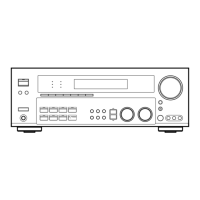
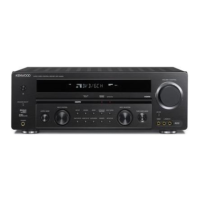
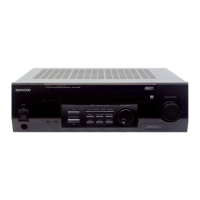


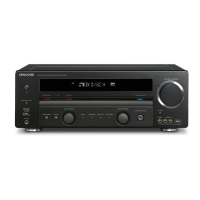
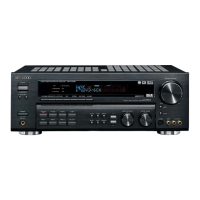
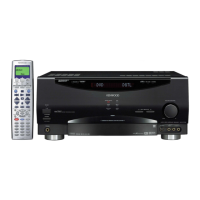


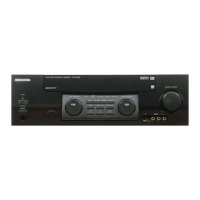
